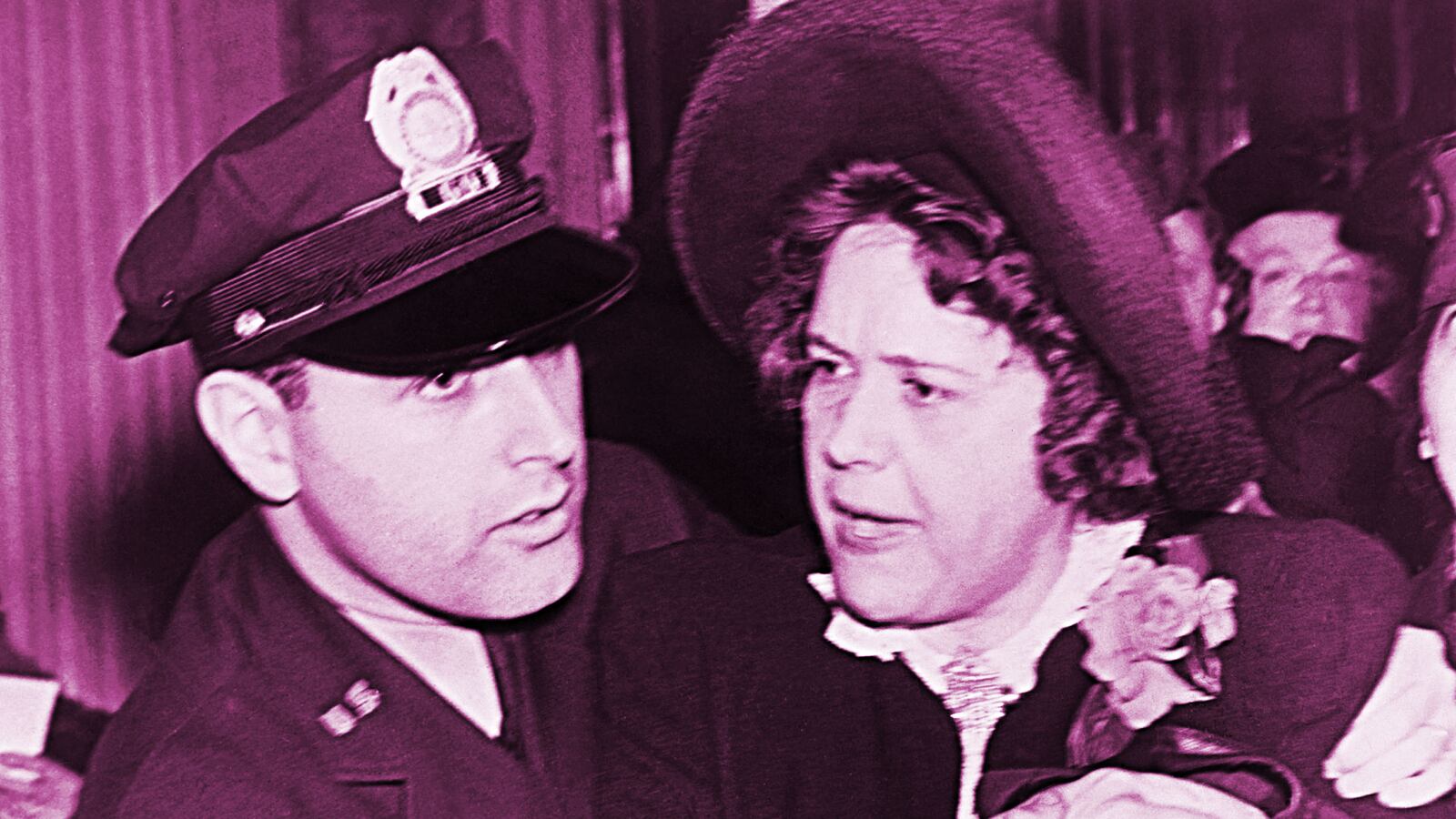When she smiled her face could look cherubic, with wide eyes and chubby cheeks conveying a calm she rarely felt. In fact, she became famous by twisting her face with such disgust and issuing such cutting remarks she could have been the Gold Medalist in demonization as America’s Animosity Olympics—1930s and 1940s edition—peaked.
She joined the chorus screeching “AMERICA FIRST!”—putting American values of tolerance, decency, and equality last. She hated blacks. She hated Communists. She hated the Roosevelts. But most of all she hated Jews. Indeed, Elizabeth Dilling earned the nickname a Nazi newspaper gave her: “the female Fuhrer.”
In a twisted salute to womanpower, this Chicagoland matron competed with the populist demagogues Father Charles Coughlin and Gerald L.K. Smith in denouncing what they called Franklin Roosevelt’s “Jew Deal” and Communism as an international Jewish conspiracy. Born in Chicago as Elizabeth Kirkpatrick in 1894, married to a wealthy lawyer Albert Dilling in 1918, this anxious, frustrated woman exploited the era’s anxieties, trying to make everyone else as miserable as she was.
As upper-crust Americans, she and her husband traveled widely; yet as small-minded provincials they accumulated resentments as zealously as most tourists collect souvenirs. In England, Dilling used British anti-Americanism to vow she would oppose intervening ever again militarily to save those ingrates. In “Red Russia,” Elizabeth Dilling struck the ideological motherlode, finding much to hate. She abhorred Soviet atheism, oppression, and privation, from the secret police to “the forced labor” to the “squalid crowded living quarters.” And she dreaded the Communist threat: “Our world revolution will start with China and end with the UNITED STATES.”
Horrified by these Soviet abominations, she felt betrayed when she returned home “to the ‘NICE’ North Shore of Chicago,” and the “intelligentsia” there “were rendering brainwashed reverence to the “great Soviet Experiment.”
Somehow, rather than blaming universalism, atheism, socialism, totalitarianism, even liberalism, she blamed Judaism, because her Soviet tour guides were Jewish. Karl Marx’s descent from a “long line of rabbis” convinced her that “Talmudic Judaism” is “the progenitor of modem Communism and Marxist collectivism.”
In leaping from disliking one Jew to condemning Judaism, Dilling joined the long line of anti-Semitic obsessives, from ancient times to today, who use this durable and apparently all-purpose adhesive to shore up weak, anxiety-exploiting ideologies. This anti-Jew glue was working for the Communists and the anti-Communist Nazis. Today, it bridges the contradictions of the Far Left’s anti-Zionist Red-Green alliance and the alt-Right’s anti-diversity white bullies.
Inevitably, Dilling was blind to anything good about Jews – or anything bad about their enemies. “The German people under Hitler are contented and happy,” she would report.
With money from her inheritance, her husband, and fellow haters like the misanthropic auto magnate Henry Ford, Elizabeth Dilling ran a one-woman crusade as a “professional patriot” – paralleling other populists who were also using the Great Depression to stir ugly bigotry. She was perpetually on the road and on the radio. Her third book The Octopus was so anti-Semitic even she realized she needed a pseudonym for that one.
In 1932, Dilling cofounded the Paul Reveres, a nationwide organization to fight Communism. Two years later, this proto-McCarthyite in pumps, self-published The Red Network: A “Who’s Who” and Handbook of Radicalism for Patriots, identifying the Commies she believed were destroying America. In 1936, hoping to stop Franklin Roosevelt’s re-election, she published The Roosevelt Red Record and its Background, targeting Eleanor Roosevelt for loving blacks, Communists, and Jews.
Always cloaking her antagonism in patriotism, in 1938 Dilling founded the Patriotic Research Bureau, libeling her enemies regularly in newsletters. “The Jews can never prove that I'm anti-Semitic, I'm too clever for them,” she boasted privately, when she published The Octopus under the name Rev. Frank Woodruff Johnson. Little did she realize that her supposed expose of world Jewry would itself be exposed and ridiculed during humiliating, divorce proceedings with her compulsively unfaithful husband within two years.
Dilling was so prominent—and shrill—she inspired the novelist Sinclair Lewis’s character “Adelaide Tarr Gimmitch” for his 1935 novel—and current best-seller—It Can’t Happen Here. Gimmitch, a prickly “political Mae West,” helps catapult America into Fascist hell.
The fight over America’s entry into World War II gave Dilling’s hatred new inspiration – and resonance. As isolationist fears grew, so did Dilling’s fame. She helped lead the “Mother’s Movement,” expertly chronicled by Glen Jeansonne in Women of the Far Right, claiming that as mothers, women particularly hated war. Naturally, she weaved these pacifist arguments into her usual patchwork quilt of anti-Communist, anti-Semitic, anti-New Deal, and anti-British patriotic sounding claptrap.
Dilling and her allies seized on the fight over Lend-Lease to launch their own Women’s March, the “Mothers' Crusade to Defeat H. R. 1776.” In February, 1941, hundreds joined her in shouting “Kill Bill 1776, not our boys.” She warned “If the Jews succeed in hollering America into war, what happened to Jews in Germany might seem like a kindergarten compared to what they might get in America when the dead bodies start coming home, as Americans are a much hotter-tempered people.” Such hysteria, had some women worrying, “She’s giving the movement a black eye.”
A broader backlash grew, especially after Dilling continued opposing the war despite Pearl Harbor. The occasional skirmish with police now mushroomed into high-level governmental prosecution, what we could call the “Brown Shirt Scare” or “the anti-Red Scare.” The Great Sedition Trial of 1944 ensnared Dilling and 27 other defendants. The government dropped the case in 1946, but Dilling’s reputation never recovered.
She lived for another two decades, until 1966, growing lonelier, angrier, shriller, churning out a steady stream of pseudo-scholarship, sharp insults, and obsessive-Jew hatred. She called Dwight Eisenhower “Ike the kike,” and Kennedy’s administration, “the Jew Frontier.” Branding herself as “Elizabeth Dilling, D.D.T.,” for “Doctor of Damned Talmud,” she pored over the ancient Jewish tomes, to make her case in The Plot Against Christianity that “Talmudism is a conglomeration of all the demonology of ancient time.” She called desegregation a “Talmudic plot.” She ranted against Jewish organizations such as the American Jewish Committee and the B’nai Brith, as “The hub of world Jewish anti-Christ power." She dismissed the Babylonian Talmud as “pornographic, anti-Gentile and anti-Christian.” She even decided that Hitler lost because he had Jewish origins and “financing.”
Tragically, this woman who should live in infamy and obscurity is enjoying a mini-revival. In today’s perverted social media universe, where extremist bottom feeders try magnifying minor haters from the past into major contemporary inspirations, one Jew-hating website calls her “a prophetess in her own time.” It praises “her exposure of the Zionist Jewish infiltration of the United States of America and her analysis of Bolshevism, Communism and Zionism as one Beast with numerous names.” These radicals praise her for wielding “the sword of truth”; reasonable people must denounce her swamp of lies.
The female furhrer’s miserable, mean life warns us that the maternal power, patriotism, and piety she celebrated can be constructive or destructive. Her Talmudic obsession demonstrates the way hatred grows like a cancer, poisoning the soul. And Elizabeth Dilling’s anti-Semitism proves that this durable, all-purpose, Jew-glue unites bigoted bedfellows, serving as the world’s base hatred, the gateway prejudice for so many, leading them down multiple paths to depravity.
FURTHER READING:
Glen Jeansonne, Women of the Far Right: The Mother’s Movement and World War II (1996). Still, the best scholarly account of Elizabeth Dilling and her peers. Jeansonne takes her seriously as few scholars do, without endorsing her views, as some fanatics have started to do.
Sinclair Lewis, It Can't Happen Here (1935). The chilling novel that everyone is calling prescient, but we’re better off seeing as cautionary.






